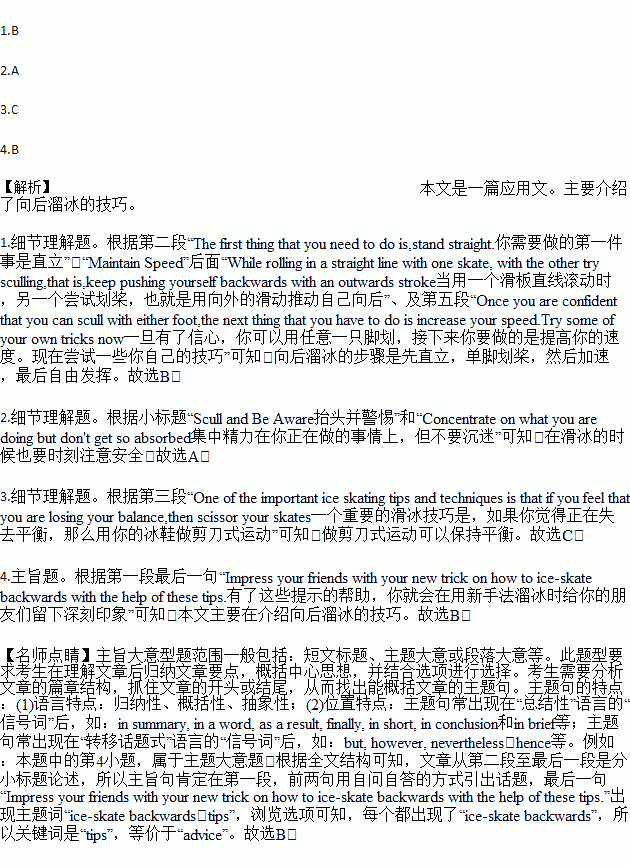题目内容
Don't you just love ice skating every winter?I am sure that since winter is approaching,your skates are set to come out,just waiting to be used.Impress your friends with your new trick on how to ice-skate backwards with the help of these tips.
Stand Straight
The first thing that you need to do is,stand straight.If you feel that you are falling backwards,just put your chin up and slightly bend your knees.
Confidence is What You Need
The most important step while learning how to skate backwards,is having enough confidence in what you are doing.How can you achieve this?By practice.Just practice rolling backwards down a gentle slope everyday or just by pushing off from a wall or something of that sort.But before you do that,make sure that the place where you are practicing is free from any kind of debris(碎片)because otherwise,you could land up in the hospital due to some accident.While going backwards,just get used to the feeling of moving backwards.One of the important ice skating tips and techniques is that if you feel that you are losing your balance,then scissor(做剪式运动)your skates.Keep practicing this till you are confident about it.
Maintain Speed
Confident now?Great!Now the next step is to maintain your speed.While rolling in a straight line with one skate, with the other try sculling(划桨),that is,keep pushing yourself backwards with an outwards stroke(滑动).Make sure that you put most of your weight on the skate which is moving straight and not the one with which you are sculling.Now,try the same thing using the other foot.Again keep doing this till you are confident enough.
Increase Your Speed Now
Once you are confident that you can scull with either foot,the next thing that you have to do is increase your speed.Try some of your own tricks now.Scull with either foot or with both at the same time.
Scull and Be Aware
While you keep one foot straight,keep sculling with the other.You can do that with both feet at the same time. Concentrate on what you are doing but don't get so absorbed,that you don't see where you are going.If you are not watching your back,you might bang(碰撞)against something or someone.
1.Which is the right order of ice-skating backwards?
a.Increasing your speed.
b.Being able to scull with one foot.
c.Being about to stand straight.
d.Trying some different tricks.
A. c→a→d→b B. c→b→a→d
C. a→c→b→d D. c→b→d→a
2.In the last paragraph the author mainly wants to express_______.
A. Keeping cautious is as important as skating
B. One must be brave to learn to ice-skate backwards
C. It’s difficult to concentrate when ice-skating backwards
D. It' s a common thing to hit someone when ice skating backwards
3.In order to keep balance when skating backwards you should_______.
A. use both your feet to scull
B. skate forward first and then backward
C. skate in the way that scissors move
D. put most of your weight on the skate with which you are sculling
4.The text is mainly to_______.
A. compare different ways of ice-skating backwards
B. offer some advice on ice-skating backwards
C. introduce the culture of ice-skating backwards
D. explain advantages of ice-skating backwards
 天天向上一本好卷系列答案
天天向上一本好卷系列答案 小学生10分钟应用题系列答案
小学生10分钟应用题系列答案

 vention?
vention?